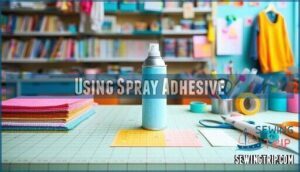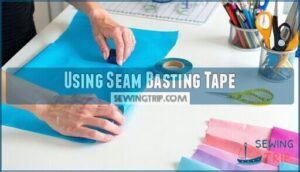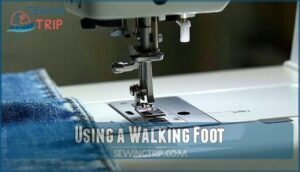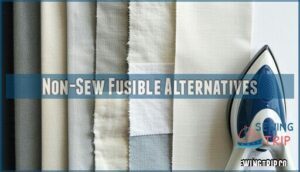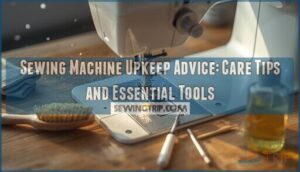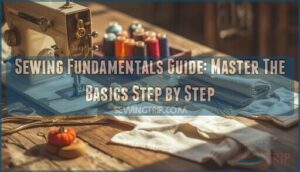This site is supported by our readers. We may earn a commission, at no cost to you, if you purchase through links.
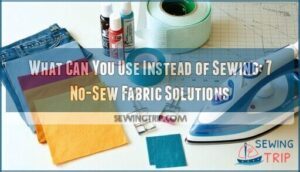
Fabric glue creates permanent bonds that withstand washing, while fusible tape melts under heat to form invisible seams.
Iron-on adhesives work like magic for hems and patches, and spray adhesives offer quick fixes for lightweight fabrics.
For temporary solutions, fabric clips and safety pins hold pieces perfectly without damage.
Binder clips work surprisingly well for thick materials, and fabric weights keep everything in place during cutting.
Each method has its sweet spot, and mastering the right technique for your specific project makes all the difference.
Table Of Contents
Key Takeaways
- You can achieve professional-looking fabric bonds using fusible tape, fabric glue, or iron-on adhesives that create permanent, washable connections without any needle skills
- Smart holding techniques like binder clips, fabric weights, and safety pins keep materials perfectly positioned during projects, eliminating frustrating pin-pricks and fabric shifting
- Spray adhesives offer both temporary and permanent bonding options, letting you reposition pieces when needed or create moisture-resistant seams for finished projects
- Each no-sew method has specific strengths—fusible tape excels at straight hems, fabric glue handles curves beautifully, and clips work best for thick or slippery materials, using fabric weights
No-Sew Alternatives to Attach Fabrics
Whether you’re dodging the needle or simply want faster results, no-sew alternatives revolutionize fabric attachment.
Fabric glue types range from permanent bonds to temporary adhesives, perfect for heat sensitive fabrics that can’t handle iron-on methods.
Fusible web strength varies by weight, making it ideal for everything from delicate silks to heavy canvas.
Best no-sew options include iron on adhesive for quick fixes, fusible tape for precise edges, and hemming tape for instant alterations.
No sew adhesive solutions save time while delivering professional results that withstand washing and wear.
Using Binder Clips or Small Clips
The magic of effortless fabric attachment lies in choosing the right clip for your project.
Smart clip choices turn tricky fabrics into easy, frustration-free crafting.
Binder clips from your office drawer make excellent sewing substitutes for heavy fabrics, while tiny metal clips work perfectly for lightweight materials. Consider clip size based on fabric thickness—larger clips for multiple layers, smaller ones for delicate work.
Smart clip placement along seam lines eliminates pin-prick frustrations and creates secure holds. These nosew methods shine when working with slippery silks or thick denims that resist traditional pins.
For instance, sewing clips offer a safer alternative to pins. Craft clips with colorful designs double as decorative elements in visible areas.
Office clips, hair clips, and clothespins serve as versatile sewing alternatives. Project suitability depends on fabric weight and desired permanence.
This nosew alternative transforms your crafting experience from painful pin-poking to smooth, efficient fabric manipulation.
Using Fabric Weights
While clipping works great for small projects, fabric weights offer superior cutting stability for larger pieces.
You’ll find these sewing alternatives transform your fabric cutting experience by providing consistent pressure across entire pattern pieces.
Fabric weights excel at fabric manipulation because they don’t puncture or distort your material.
Here’s what makes them perfect for nosew methods:
- Weight placement around pattern edges keeps everything secure
- Works with any fabric type, from delicate silks to heavy canvas
- Improves pattern accuracy by eliminating pin-induced shifting
- Handles curved edges better than clips or pins
- Provides consistent cutting stability across large surfaces
Household items work brilliantly as improvised weights.
Understanding the grams per square meter can also help you choose the right weight for the fabric.
Butter knives, soup cans, or paperweights distribute pressure evenly without damaging your fabric.
This technique particularly shines when working with slippery materials that tend to shift during cutting.
You’ll cut more precisely and save time repositioning patterns.
Using Spray Adhesive
While fabric weights hold your materials steady, spray adhesive creates the actual bond between fabrics. This versatile solution offers both temporary and permanent adhesive types, perfect for different projects.
Spray adhesive application requires proper technique. Hold the canister 10-12 inches from your fabric surface, using smooth, continuous motions for even coverage. Test on scraps first—some colors and finishes may react unexpectedly. Pre-wash fabrics without softener for ideal adhesive techniques.
Fabric bonding becomes effortless with temporary sprays allowing 1-2 minutes for repositioning, while permanent formulas create moisture-resistant bonds. Both spray adhesive types remain clear and won’t gum sewing machine needles. For crafting, consider using a repositionable spray adhesive to allow adjustments.
Ventilation needs are critical—always work in well-ventilated areas and wear protective equipment. These fabric adhesives contain volatile compounds requiring proper safety measures.
Cleanup methods vary by formula, but temporary versions typically wash out completely, making them ideal for quilting and applique work.
Using Seam Basting Tape
Beyond pinning fabrics together, seam basting tape offers a game-changing approach for temporary fabric bonding in no sew projects.
This double-sided adhesive creates strong temporary holds, allowing you to reposition fabrics for perfect pattern matching and temporary hems before final assembly.
Key advantages of seam basting tape include:
- Heat Dissipation: Adhesive dissolves during washing or ironing, leaving no residue
- Fabric Compatibility: Works effectively on various materials from delicate silks to heavy canvas
- Tape Application: Simply peel backing, press firmly, and adjust positioning as needed
Perfect for sewing machine substitutes, this sewing alternative helps beginners achieve professional results.
For applications like hemming and positioning, consider using double sided tape.
The tape prevents fabric shifting during assembly, making it ideal for matching repeat patterns on curtains or creating precise temporary hems on garments—no needles required.
Using a Walking Foot
When your sewing machine feels more intimidating than inviting, a walking foot becomes your fabric-handling superhero.
This attachment grabs both fabric layers simultaneously, feeding them through at the same rate—eliminating the slippage that makes you want to toss your machine out the window.
Walking Foot Uses shine brightest with thick fabrics like denim, canvas, and quilted materials where standard presser feet struggle.
The dual-feed mechanism provides Fabric Feed Control that prevents the dreaded "fabric sandwich slide," where your top layer travels faster than the bottom.
For Preventing Slippage on slippery satins or stretchy knits, this tool delivers Even Stitching without the puckering that sends projects to the donation pile.
Think of it as training wheels for your sewing machine—providing stability while you master fabric manipulation.
While not technically among sewing machine substitutes, walking feet address common sewing machine intimidation by making tricky fabrics manageable.
They’re essential for anyone seeking sewing alternatives that actually work with their existing equipment, transforming frustrating projects into success stories.
You can find a walking foot online for many sewing machine models.
Non-Sew Fusible Alternatives
When you can’t reach for needle and thread, fusible alternatives offer permanent fabric bonds through heat or chemical adhesion.
These modern solutions handle everything from quick repairs to complete garment construction, giving you professional results without traditional sewing skills, using permanent fabric bonds.
Fusible Tape
For seamless fabric bonding, fusible tape offers precut strips that activate with heat, creating durable connections without visible stitches.
Simply place the tape between fabric layers and press with an iron for fifteen seconds.
- Double-sided strips melting under your iron’s warmth, forming invisible bonds
- Flexible adhesive stretching with fabric movement through countless washes
- Quick activation transforming loose edges into secure seams in seconds
- Professional finish eliminating bulky stitching for clean, polished results
This nonsew method works across various fabric types, with strength variations matching different project needs.
Many retailers offer various tape products for different applications.
After tape activation, allow a brief resting period for ideal fabric compatibility and lasting adhesive performance.
Fusible Web
While tape works in strips, fusible web covers entire surfaces like an invisible mesh between fabric layers.
This adhesive for fabric melts under heat, creating permanent fabric bonding perfect for appliqués and quilting.
Web activation requires medium heat and pressing cloth for proper application techniques.
You can find various web products online.
Test fabric compatibility first—some synthetics may melt, and washing durability varies by brand, so check labels.
Project ideas include decorative patches and hemming delicate fabrics where no-sew methods shine.
Fusible Adhesive
Heat-activated fusible adhesives create permanent bonds between fabric layers without traditional stitching.
These versatile bonding agents come in powder, sheet, and spray forms, making them perfect for reinforcing high-stress areas like waistbands while maintaining fabric flexibility and washability.
- Application Techniques: Use a press cloth and iron at medium heat for 10-15 seconds to activate adhesive bonding
- Fabric Compatibility: Works on cotton, synthetics, and blends with excellent adhesive strength across material types
- Washing Durability: Maintains long-term storage stability and withstands repeated laundering cycles effectively
Fabric Glue
Squeezing fabric glue onto your project creates instant bonds without needlework.
This textile adhesive works on most materials, from cotton to synthetics.
Test fabric compatibility first, then apply evenly for maximum bond strength.
Most formulas cure within 37-47 minutes and pass washability tests.
Choose nosew alternatives like Aleene’s for permanent holds with minimal residue removal needed, ensuring a strong and lasting adhesive.
Hot Glue
Hot glue might seem like your crafting superhero, but it’s more like that friend who’s great at parties but terrible at formal dinners—use it wisely on fabric projects.
Hot glue is your party friend—fun but unreliable for serious fabric commitments.
When wielding your Glue Gun Safety arsenal, remember that hot glue operates at around 260°F, making Fabric Compatibility essential for success. While it excels in DIY projects and Quick fixes, it’s not always the best choice for delicate materials.
Here’s your hot glue reality check:
- Best Glue Sticks: Choose all-temperature or low-temp varieties for better fabric results
- Project Ideas: Perfect for costume details, home décor, and craft embellishments
- Removal Techniques: Heat with iron and peel carefully, though complete removal can be tricky
- Nonsew methods: Works great on sturdy fabrics like canvas and denim for temporary bonds
- Sewing alternatives: Ideal when you need instant gratification but can sacrifice flexibility
Hot glue creates strong initial bonds but lacks the flexibility that fabric movement demands, making it better suited for decorative applications than functional garment construction.
Tips for Successful Non-Sew Fusible Alternatives
Success with no-sew fusible alternatives starts with proper preparation. Test your chosen adhesive on fabric scraps first—different materials react differently to heat setting and adhesive type.
Choose the right product: fusible tape works well for straight hems, while fusible web handles curves and appliqués better. Stitch witchery excels for permanent bonds, and fusible adhesive suits lightweight fabrics.
Master layering techniques by placing materials evenly, avoiding wrinkles. Perfect your ironing techniques using proper temperature and timing. Work on protected surfaces, and remember—patience beats rushing every time.
Frequently Asked Questions (FAQs)
What can I use instead of sewing?
You’ve got several great alternatives to traditional sewing.
Fusible tape and interfacing use heat to bond fabrics together, while fabric glues create permanent bonds without any tools.
Iron-on patches, hem tape, and Velcro strips offer quick fixes that’ll save you time and effort.
What is a sewing alternative?
You don’t need a needle and thread when push comes to shove.
Try fusible tape, fabric glue, iron-on patches, or interfacing to bond fabrics with heat or adhesive for quick repairs and alterations.
Is fabric glue a good alternative to sewing?
Yes, fabric glue is an excellent sewing alternative.
It creates permanent, washable bonds on most fabrics, dries clear and flexible, and works great for hems, repairs, appliqués, and decorative projects without needlework skills.
What are some sewing alternatives for garment mending?
Fusible tape, fabric glue, and iron-on patches work great for quick garment fixes. They’re perfect when you need fast repairs without threading needles or wrestling with sewing machines.
Is there a no-sew alternative to sewing?
You’ve got fantastic no-sew alternatives that’ll revolutionize your fabric fixes.
Fusible tapes, fabric glues, iron-on products, and adhesive solutions create permanent bonds without threading a single needle—saving time while delivering professional results.
What can I use instead of pinning fabric?
You’ll love basting spray—it temporarily holds fabric layers together without pins.
Double-sided basting tape also works great for positioning pieces.
Pattern weights keep templates flat, and fusible tape creates temporary bonds that dissolve when heated.
What is a substitute for stitching?
Think of fabric bonding as weaving magic without needles—you can use fusible tape, fabric glue, or iron-on products to create permanent bonds.
These alternatives activate with heat or pressure, giving you strong, washable seams that’ll outlast traditional stitching, using methods like fusible tape.
How to make something tighter without sewing?
Use elastic bands, drawstrings, safety pins, or fabric tape to gather excess material. Iron-on hem tape creates smaller waistbands. Hook-and-loop strips provide adjustable closures for quick fixes.
Can you hem pants without sewing skills?
My friend Sarah dreaded hemming her new jeans until she discovered fusible hem tape—just iron it on and you’re done!
You can hem pants using fusible tape, fabric glue, or iron-on adhesives without any sewing skills required.
How do you attach patches without needles?
Attach patches using iron-on adhesive backing, fusible web, or fabric glue. Simply position the patch, apply heat with an iron, or spread glue evenly and press firmly for permanent bonding.
Conclusion
Think of these no-sew methods as your fabric toolkit’s secret weapons—each one perfectly suited for different missions.
Whether you’re exploring what can you use instead of sewing for quick repairs or major projects, you’ve now got seven reliable alternatives.
From fusible tapes that create invisible bonds to clips that hold everything perfectly in place, these techniques prove that traditional stitching isn’t always necessary.
Pick your method based on your fabric type and permanence needs, and you’ll achieve professional-looking results without threading a single needle.
- https://aleenes.com/products/aleenes-no-sew-fabric-glue-4-fl-oz
- https://www.magnetichoop.com/blogs/news/top-fabric-glue-alternatives-discover-the-best-substitutes-for-your-projects
- https://cmongetcrafty.com/no-sew-no-problem-how-to-work-with-fabric-without-a-stitch/
- https://www.moodfabrics.com/blog/no-sew-alternatives-to-sewing/
- https://www.wherethesmileshavebeen.com/how-to-cut-fabric-and-make-a-no-sew-applique/

